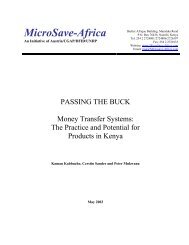Create successful ePaper yourself
Turn your PDF publications into a flip-book with our unique Google optimized e-Paper software.
the mid- and late 2000s, the company under-<br />
took some promising initiatives with PEPFAR<br />
funding. In Zambia, the Market Access Trade<br />
and Enabling Policies Project provided HIV/<br />
AIDS training for businesspeople; in Lesotho,<br />
ECIAfrica organized a powerful grassroots<br />
group, the Lesotho Apparel Alliance, to fight<br />
HIV/AIDS in the clothing industry; and in Ethiopia,<br />
<strong>DAI</strong> administered a novel “urban agriculture”<br />
program that gave women affected by<br />
HIV/AIDS the tools they needed to raise their<br />
standards <strong>of</strong> living and nutrition.<br />
As these initiatives unfolded, <strong>DAI</strong> was learning<br />
to respond to yet another international health<br />
threat. H5N1, the highly pathogenic avian<br />
influenza virus, seemed to emerge suddenly. In<br />
the mid-2000s, a series <strong>of</strong> outbreaks hit Asia,<br />
especially China, Indonesia, and Turkey. In<br />
2005, USAID transformed a long-term project<br />
in Armenia—adjacent to Turkey, one <strong>of</strong> the<br />
outbreak countries—into an avian influenza<br />
initiative, and suddenly <strong>DAI</strong> personnel had an<br />
unexpected challenge on their hands. In a classic<br />
case <strong>of</strong> give and take between donor and<br />
implementer, <strong>DAI</strong> urged USAID to focus less on<br />
veterinary issues and more on cultural problems.<br />
“We’re not going to change the behavior<br />
<strong>of</strong> chickens,” insisted Gary Kilmer, Chief <strong>of</strong> Party<br />
at the time, “we’re going to change the behavior<br />
<strong>of</strong> people.”<br />
That fall, <strong>DAI</strong> converted a livestock health<br />
program into one <strong>of</strong> USAID’s largest avian<br />
influenza response programs, mapping poultry<br />
sectors, designing compensation schemes for<br />
<strong>DAI</strong>’s work to combat HIV/AIDS went beyond medical concerns to address<br />
economic and legal issues, as well. Above: A march organized by a <strong>DAI</strong> project<br />
in Zimbabwe publicizes a program to provide legal services to HIV/AIDSaffected<br />
people. Below: Orphans in <strong>DAI</strong>’s urban agriculture program show <strong>of</strong>f<br />
the food they have grown using an innovative growbag system.<br />
99



